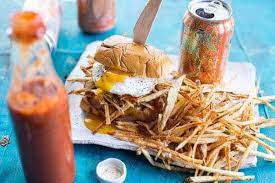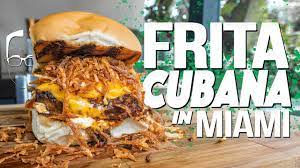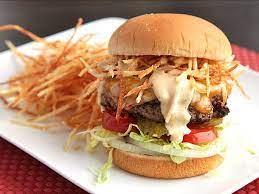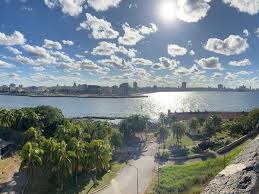LA FRITA CUBANA, FUE Y SEGUIRA SIENDO LA REINA DE LOS PLATOS CALLEJEROS. PHOTOS.
Si algo seguramente recuerdan con nostalgia la gente de mi generación, son los puestos de fritas y los puestos de venta ostiones. Estaban en todas partes, eran la comida callejera por excelencia por barata y por exquisita y a pesar de la gran competencia, la demanda siempre era insuficiente por sus atractivos en todos los sentidos.
El puesto de fritas ocupó un lugar prominente dentro de las instituciones de los barrios habaneros, al nivel de la bodega, el café de tres quilos, el puesto de venta de frutas, viandas y vegetales de chinos, la carnicería y la quincalla.
Mientras que bodegueros y los chinos no necesitaban de ningún tipo de marketing ni propaganda comercial, los primeros porque tenían casi todo lo que se necesitaba para comer en una casa salvo vegetales y viandas y productos cárnicos y las facilidades para pagarlo en el momento que se pudiera, y los chinos con sus puestos donde encontrabamos todo tipo de vegetales, viandas y frutas y además exquisitos helados y por una impresionante oferta de alimentos ligeros, como eran las frituras o bollitos de bacalao, de papa, de malanga, de carita, los llamados “cabeza de chino con piojo” y muchos otros, todo muy barato, que hicieron que a esos comercios se les llamara “casas de socorro”, lo que después se extendió a los puestos de fritas. Y aún hoy en día aseguro que es difícil encontrar un helado más delicioso que el que hacían los chinos.
Después estaban otros platillos callejeros muy recurridos, como eran las papas rellenas, el pan con lechón, los tamales y el perro caliente o hot-dog, el que llegó a ocupar un puesto más elitista junto con el sándwich cubano al venderse principalmente en cafeterías, junto con batidos de frutas, de chocolate, de leche malteada o de trigo.
LA FRITA, LA REINA
La frita fue una de las ofertas gastronómicas más populares de La Habana, si no la más popular y su origen , como todo lo bueno mucha gente se lo disputa, parece estar bien claro y todo parece apuntar al carbonero gallego Sebastián Carro Seijido, el cual al ver que el gas licuado comenzaba a hacerse el preferido como combustible doméstico, vio como una necesidad dedicarse a otro negocio.
Puso entonces un puesto de fritas en los bajos de su casa, en Zapata y A en el Vedado, y en poco tiempo apenas daba abasto ante tantas demandas. Abrió entonces la cafetería El Bulevar, en 23 entre 2 y 4,y poco después otra cafetería en la calle Paseo entre Tercera y Quinta, que es la actual “La Cocinita”. Cuando triunfó la Revolución, sus planes eran los de expandirse hacia otras zonas habaneras, pero como a muchos, le truncaron sus iniciativas.
¿Cúal fue el éxito de Sebastián?: la originalidad. Comenzó haciendo diferentes mezclas a partir de carne de ternera, chorizo fresco, cebolla, huevo, leche, pan rallado, pimentón, sal, aceite de oliva, todo frito al carbón y servido en pan redondo con catsup y papitas fritas estilo juliana y cebolla finamente picada. Su consistencia es muy suave y rápidamente se hizo muy popular, apareciendo cientos de carritos en muchas esquinas habaneras ofertando las fritas, las que fueron desplazando la preferencia hacia los otros alimentos rápidos callejeros tradicionales que hemos mencionado. Esos mismos puestos de venta de fritas, a un precio inicial de cinco centavos, también ofertaba el pan con bisté a lo cubano, a un precio de quince centavos y papas rellenas a diez.
Puestos de fritas y friteros famosos hubo muchos en La Habana. En casi todas las esquinas concurridas había uno, todos en el barrio teníamos nuestro preferido y se mantienen en nuestra memoria los que estaban situados en los portales de los cines, de las salas de eventos deportivos, hospitales, funerarias, paradas de ómnibus, y hasta junto a bodegas y almacenes, dondequiera que tuvieran espacio para ubicarse aparecían clientes. Eran famosos los que estaban situados frente al Minimax de Kasalta en la entradas de Miramar y los que pululaban por decenas en la Quinta Avenida desde la rotonda de la Playa y frente a los numerosos bares y cabarés que allí había.
El gran fritero fue el gallego Sebastián Carro Seijido, el hombre que logró aristocratizar la frita usando solo los mejores productos y trabajando con limpieza extrema, cortesía y sobre todo amabilidad con los clientes femeninos, que eran los que arrastraban a toda la familia.
Algunos dicen que Sebastián Carro tuvo en mente la hamburguesa norteamericana, pero lo cierto es que esta no despegó masivamente sino muchos años después, pero lo cierto es que la combinación de la frita era totalmente original, sabrosa y nutritiva además de barata y fácil de preparar y de ahí su éxito en toda Cuba. La gente prefirió la frita (debidamente envuelta en papel de china) por encima de otros productos alimenticios callejeros populares.
Jorge Mañach en una de sus Estampas de San Cristóbal (de La Habana) describió que la frita cumplía con el gusto de los cubanos por los productos fritos y que los puestos donde se elaboraban y vendían eran parte inseparable de la imagen habanera, aportando junto con el del café y el coñac, las frutas y los perfumes españoles baratos como el Varon Dandy, Canoe y Dana, al olor característico de la capital.
Llegó a ser tan popular la frita y tan recurrente su consumo que la frase de “no gané ni para el chicle”, que entonces costaba un centavo, se fue sustituyendo por “no gané ni para la frita”, palabra que identificaba la comida.
En cualquier caso, las fritas se convirtieron pronto en la comida perfecta después de un juego de béisbol, una tarde en el cine o para consumir por la noche tras salir de algunos de los bares de La Habana.
Pero con el ascenso al poder de la revolución en 1959, las fritas comenzaron a desaparecer poco a poco. Miles de cubanos salieron de la isla mientras se nacionalizaban los negocios y propiedades, y el principal componente de la frita, la carne molida, se hizo un producto deficitario y después prohibitivo. Pronto desaparecieron los carritos que vendían fritas.
La desaparición definitiva de las fritas comenzó en 1968, con la llamada “ofensiva revolucionaria” que eliminó los negocios particulares, por pequeños que fueran. Desapareció así la comida rápida que ocupaba el primer lugar en la preferencia de los cubanos y a la que solo le disputaba su lugar el café con leche, que también había sucumbido a los embates socialistas.
Aquella mezcla de carnes condimentadas acompañada de un refresco o una copita de ostiones, una fórmula barata y alimenticia para saciar el hambre y que fue imponiéndose entre todas las capas sociales, como ocurrió en su momento con el bacalao y el tasajo, que pasaron de ser comida de esclavos a posesionarse como preferidos en todas las mesas cubanas.
EL RENACER DE LA FRITA
Si hay en el mundo un lugar donde la frita podía renacer es sin duda Miami, por la extensa concentración de cubanos en esa ciudad, mayor que ninguna otra ciudad de Cuba excepto La Habana.
Ya las hamburguesas dominaban el mercado de comidas rápidas y la competencia con las cadenas era difícil, pero si los cubanos fueron capaces de recrear exitosamente los restaurantes, librerías, tiendas, marcas comerciales de todo tipo en particular gastronómicas, ¿cómo no iba a triunfar la frita cubana?.
Poco a poco la frita se fue convirtiendo, junto con el congrí, el lechón asado, los tamales, los pastelitos de guayaba, de coco y de carne, el café cubano y muchos otros productos, una de las mayores muestras de la experiencia cubanoamericana.
Los cubanos han creado variadas, innovadoras y modernas versiones de la frita, lo que hace que su clientela aumente día a día, mientras en Cuba, la mayoría de la población, salvo los más viejos, no han probado una frita en su vida.
THE CUBAN FRITA WAS AND WILL CONTINUE TO BE THE QUEEN OF STREET DISHES. PHOTOS
If people of my generation remember something with nostalgia, it is the fried food stalls and the oyster stalls. They were everywhere, they were the street food par excellence because they were cheap and exquisite, and despite the great competition, the demand was always insufficient due to their attractions in every way.
The fried food stand occupied a prominent place within the institutions of the Havana neighborhoods, at the level of the bodega, the three-kilo coffee, the Chinese fruit, food and vegetable stall, the butcher shop and the junk shop.
While winemakers and the Chinese did not need any type of marketing or commercial advertising, the former because they had almost everything that was needed to eat in a house except vegetables and meat products and meat products and the facilities to pay for it when it was possible. , and the Chinese with their stalls where we found all kinds of vegetables, meats and fruits and also exquisite ice creams and an impressive offer of light foods, such as fried foods or cod, potato, malanga, little face buns, the so-called “Chinese head with louse” and many others, all very cheap, which led to these shops being called “relief houses”, which later extended to fried food stalls. And even today I assure you that it is difficult to find a more delicious ice cream than the one made by the Chinese.
Then there were other popular street dishes, such as stuffed potatoes, bread with suckling pig, tamales and the hot dog, which came to occupy a more elite position along with the Cuban sandwich as it was sold mainly in cafeterias. along with fruit, chocolate, malted or wheat milk shakes.
THE CUBAN FRITA, THE QUEEN
The frita was one of the most popular gastronomic offerings in Havana, if not the most popular and its origin, like all good things, many people dispute, seems to be very clear and everything seems to point to the Galician charcoal burner Sebastián Carro Seijido, who Seeing that liquefied gas was beginning to become the preferred domestic fuel, he saw the need to dedicate himself to another business.
He then set up a frita stand on the ground floor of his house, on Zapata and A in Vedado, and in a short time he could barely keep up with so many demands. He then opened the El Bulevar cafeteria, at 23 between 2 and 4, and shortly after another cafeteria on Paseo street between Tercera and Quinta, which is the current “La Cocinita”. When the Revolution triumphed, his plans were to expand to other Havana areas, but like many, his initiatives were cut short.
What was Sebastián’s success?: originality. He began by making different mixtures from beef, fresh chorizo, onion, egg, milk, breadcrumbs, paprika, salt, olive oil, all fried over charcoal and served in round bread with ketchup and julienne-style French fries and finely chopped onion. minced. Its consistency is very smooth and it quickly became very popular, with hundreds of carts appearing on many street corners in Havana offering fried foods, which gradually shifted preference towards the other traditional street fast foods that we have mentioned. Those same stalls selling fried potatoes, at an initial price of five cents, also offered bread with Cuban steak, at a price of fifteen cents, and stuffed potatoes for ten.
There were many famous frita stalls and friteros in Havana. There was one on almost every crowded corner, everyone in the neighborhood had our favorite and the ones that were located in the doorways of movie theaters, sports venues, hospitals, funeral homes, bus stops, and even remain in our memory. next to warehouses and warehouses, wherever they had space to stand, customers showed up. The ones that were located in front of the Kasalta Minimax at the entrance to Miramar and those that swarmed by the dozens on Fifth Avenue from the Playa roundabout and in front of the numerous bars and cabarets that were there were famous.
The great fritter was the Galician Sebastián Carro Seijido, the man who managed to aristocratize the fritter using only the best products and working with extreme cleanliness, courtesy and above all kindness with the female customers, who were the ones who dragged the whole family.
Some say that Sebastián Carro had the North American hamburger in mind, but the truth is that it did not take off massively until many years later, but the truth is that the combination of the frita was totally original, tasty and nutritious as well as cheap and easy to prepare. and hence its success throughout Cuba. People preferred the frita (properly wrapped in tissue paper) over other popular street food items.
Jorge Mañach in one of his Estampas de San Cristóbal (from Havana) described that the frita complied with the taste of Cubans for fried products and that the stalls where they were made and sold were an inseparable part of the Havana image, contributing along with that of coffee and cognac, fruits and cheap Spanish perfumes such as Varon Dandy, Canoe and Dana, the characteristic smell of the capital.
The fried food became so popular and its consumption was so recurrent that the phrase “I didn’t even earn for the gum”, which then cost a penny, was gradually replaced by “I didn’t even earn for the fried gum”, a word that identified the food.
In any case, fritas soon became the perfect meal after a baseball game, an afternoon at the movies, or to eat at night after leaving some of Havana’s bars.
But with the rise to power of the revolution in 1959, the fritas began to disappear little by little. Thousands of Cubans left the island while businesses and properties were nationalized, and the main component of the frita, ground beef, became a deficient and later prohibitive product. The carts selling fries soon disappeared.
The definitive disappearance of fritas began in 1968, with the so-called “revolutionary offensive” that eliminated private businesses, however small they were. Thus, the fast food that occupied the first place in the preference of Cubans disappeared and to which only coffee with milk disputed its place, which had also succumbed to the socialist attacks.
That mixture of seasoned meats accompanied by a soft drink or a glass of oysters, a cheap and nutritious formula to satisfy hunger and that was imposed among all social classes, as happened at the time with cod and jerky, which went from being slave food to take possession as favorites on all Cuban tables.
THE REBIRTH OF THE FRITA
If there is a place in the world where the frita could be reborn, it is undoubtedly Miami, due to the extensive concentration of Cubans in that city, greater than any other city in Cuba except Havana.
Hamburgers already dominated the fast food market and competition with chains was difficult, but if Cubans were able to successfully recreate restaurants, bookstores, shops, commercial brands of all kinds, particularly gastronomic ones, how could hamburgers not succeed? Cuban frita?.
Little by little, the frita became, together with the congrí, the roast suckling pig, the tamales, the guava, coconut and meat cakes, the Cuban coffee and many other products, one of the greatest samples of the Cuban-American experience.
Cubans have created varied, innovative and modern versions of the frita, which means that their clientele increases day by day, while in Cuba, the majority of the population, except the oldest, have never tasted a frita in their lives.
Agencies/ Wiki/ NostalgiaCubana/ Carlos RodriguezB./ Extractos/ Excerpts/ Internet Photos/ Arnoldo Varona/ www.TheCubanHistory.com
THE CUBAN HISTORY, HOLLYWOOD.



 THE CUBAN FRITA was and will continue to be the Queen of the Street Dishes. PHOTOS. * LA FRITA CUBANA, fué y seguirá siendo la Reina de los Platos Callejeros. PHOTOS.
THE CUBAN FRITA was and will continue to be the Queen of the Street Dishes. PHOTOS. * LA FRITA CUBANA, fué y seguirá siendo la Reina de los Platos Callejeros. PHOTOS.








